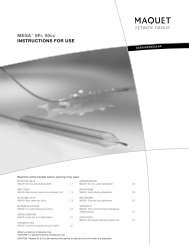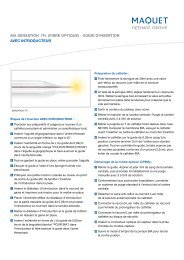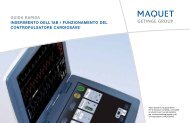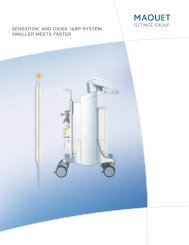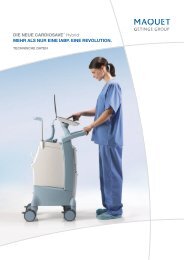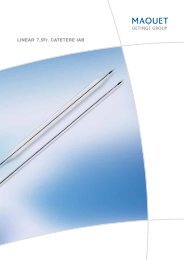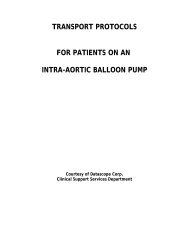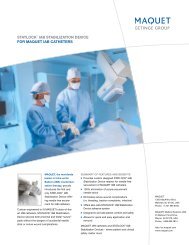mega® iab catheter instructions for use - MAQUET Cardiac Assist
mega® iab catheter instructions for use - MAQUET Cardiac Assist
mega® iab catheter instructions for use - MAQUET Cardiac Assist
Create successful ePaper yourself
Turn your PDF publications into a flip-book with our unique Google optimized e-Paper software.
| 4 | MEGA IAB | Instructions <strong>for</strong> Use |<br />
8. Ensure that the balloon membrane is inflating and deflating in<br />
an unrestrained manner and not restrained as a result of lodging<br />
beneath a plaque, within a subintimal space, within the subclavian<br />
artery, aortic arch, abdominal aorta, or if the balloon membrane<br />
volume is too large <strong>for</strong> the specific patient's aorta.<br />
WARNING<br />
If you note any restraint, unusual folding patterns of the balloon<br />
membrane or flexing of the inner lumen immediately reposition the<br />
IAB <strong>catheter</strong>. The life of a balloon membrane may be unpredictably<br />
shortened as a result of restraint, which could lead to a leak.<br />
9. If you observe unusual bleeding or subcutaneous hematoma at the<br />
insertion site, treat appropriately.<br />
10. Evaluate peripheral pulses. If the distal pulse is not satisfactory or<br />
signs of limb ischemia are present, exercise discretion concerning<br />
the continuation of IAB pumping.<br />
11. Restrain movement of the IAB <strong>catheter</strong> by securing the suture pads<br />
and the Y-fitting to the skin using the STATLOCK® Stabilization<br />
Device (See Figure 13) or sutures. You also may secure the Y-fitting<br />
to the patient with tape. (See Figure 14)<br />
12. Apply a dressing to the insertion site using sterile technique<br />
according to hospital policy.<br />
NOTE: If using the STATLOCK® Stabilization Device, please refer to the<br />
STATLOCK® Stabilization Device Instructions <strong>for</strong> Use included in the MEGA<br />
balloon box.<br />
Figure 13<br />
Figure 14<br />
STATLOCK®<br />
STABILIZATION DEVICE<br />
TAPE<br />
SUTURE PADS<br />
C. PRESSURE MONITORING THROUGH THE INNER LUMEN<br />
Figure 15<br />
INFUSION BAG<br />
500ml STERILE<br />
IV SOLUTION<br />
MAINTAINED AT<br />
300 mmHg<br />
ARTERIAL<br />
RECIPIENT<br />
SET<br />
TO ARTERIAL<br />
PRESSURE INPUT<br />
ON IAB PUMP<br />
NOTE: ALL FITTINGS MUST BE LEAK FREE.<br />
STOPCOCK<br />
TRANSDUCER<br />
CONTINUOUS<br />
FLUSHING<br />
DEVICE<br />
MAXIMUM 8 Ft. (2.5 METERS)<br />
PRESSURE TUBING<br />
THREE-WAY<br />
STOPCOCK<br />
TO LUER CONNECTION ON<br />
CATHETER EXTENDER<br />
PRECAUTION<br />
For optimal signal quality, <strong>use</strong> no more than 8 feet (2.5 meters)<br />
maximum of pressure tubing between the transducer and female luer<br />
hub of the Y-fitting.<br />
If monitoring pressure through the inner lumen, <strong>use</strong> a standard arterial<br />
pressure monitoring apparatus connected to a three-way stopcock. (See<br />
Figure 15) Connect the three-way stopcock to the female luer hub of the<br />
inner lumen. A 3cc/hour continuous flow through the inner lumen is<br />
recommended. The anticoagulation dosage should be in accordance with<br />
standard hospital practice <strong>for</strong> arterial pressure lines and may be modified,<br />
on physician discretion, <strong>for</strong> patients receiving anticoagulation therapy.<br />
Per hospital policy, a fast <strong>for</strong>ward flush may be per<strong>for</strong>med hourly to help<br />
maintain patency of the inner lumen.<br />
PRECAUTIONS DURING PRESSURE MONITORING THROUGH IAB<br />
CATHETER<br />
1. Use a standard flushing apparatus <strong>for</strong> arterial pressure monitoring<br />
with the inner lumen. Careful technique should be <strong>use</strong>d in the set<br />
up and flushing of the arterial pressure monitoring apparatus to<br />
minimize the risk of an embolus entering the aorta where it could<br />
potentially enter the carotid or coronary arteries.<br />
2. Aspirate and discard a 3cc volume of blood from the inner lumen<br />
prior to attaching a flushing apparatus to the female luer hub.<br />
3. Ensure that all air bubbles are removed from the inner lumen and<br />
flushing apparatus. In addition, tap the Y-fitting to remove all air<br />
bubbles.<br />
4. Prior to fast flushing, stop IAB pumping to reduce the risk of an<br />
embolus entering the aortic arch should an embolus be ejected<br />
from the inner lumen.<br />
5. For optimal signal quality the inner lumen should not be <strong>use</strong>d <strong>for</strong><br />
blood sampling.<br />
6. Always aspirate 3cc initially if the inner lumen aortic pressure<br />
signal becomes damped. If you meet resistance during aspiration,<br />
consider the inner lumen to be occluded. Discontinue the <strong>use</strong> of the<br />
inner lumen by placing a luer cap on the female luer hub.<br />
7. The <strong>use</strong> of in-line filters or other devices can potentially alter the<br />
appearance of the arterial pressure wave<strong>for</strong>m.<br />
8. Do not over-tighten connections.<br />
RECOMMENDATIONS FOR ACHIEVING OPTIMAL PRESSURE<br />
SIGNAL QUALITY<br />
1. Use no more than 8 ft. (2.5 m) of a low compliance pressure tubing<br />
such as that supplied by <strong>MAQUET</strong>/Datascope in the IAB Insertion<br />
Kit between the transducer and Y-fitting of the <strong>catheter</strong>.<br />
2. Once the <strong>catheter</strong> is in place, aspirate and discard 3cc of blood from<br />
the inner lumen and then immediately per<strong>for</strong>m a manual flush<br />
using a syringe filled with 3cc to 5cc of flush solution. This will<br />
minimize the chances of stagnant blood clotting in the inner lumen.<br />
3. Apply only gentle <strong>for</strong>ce to the syringe when aspirating the inner<br />
lumen.<br />
4. Do not <strong>use</strong> a R.O.S.E. (Resonance Over Shoot Eliminator) or other<br />
damping device.<br />
5. Remove air from flush bag prior to pressurizing.<br />
6. Prime the pressure set-up using gravity flush.<br />
7. Maintain 300mmHg of pressure on the flush solution and elevate it<br />
above the transducer.<br />
8. Whenever the inner lumen of the IAB becomes filled with blood<br />
(such as after aspiration), the flush valve should be activated <strong>for</strong> a<br />
minimum of 15 seconds in addition to the time it takes to clear the<br />
pressure tubing of blood.<br />
9. Ensure that all air bubbles are removed from the inner lumen and<br />
flushing apparatus.<br />
10. Use room temperature flush solution.<br />
D. MANUALLY INFLATING AND DEFLATING THE IAB CATHETER<br />
PRECAUTION<br />
The IAB <strong>catheter</strong> should not remain inactive (i.e., not inflating and<br />
deflating) <strong>for</strong> more than 30 minutes beca<strong>use</strong> of the potential <strong>for</strong><br />
thrombus <strong>for</strong>mation.<br />
To keep the IAB <strong>catheter</strong> active in the event of pump failure, manually<br />
inflate and deflate the IAB as follows:<br />
WARNING<br />
D o not per<strong>for</strong>m manual inflation of the IAB with the <strong>catheter</strong> extender<br />
tubing attached to the IAB <strong>catheter</strong>.<br />
1. Detach the <strong>catheter</strong> extender from the IAB <strong>catheter</strong>’s male luer fitting.<br />
2. Attach the supplied three-way stopcock and syringe to the IAB<br />
<strong>catheter</strong>'s male luer fitting.<br />
WARNING<br />
NEVER INJECT AIR INTO THE INNER LUMEN (female luer hub).<br />
3. Aspirate to assure blood is not returned through the extracorporeal<br />
tubing.<br />
WARNING<br />
If you aspirate blood from the male luer fitting of the extracorporeal<br />
tubing, immediate removal of the IAB <strong>catheter</strong> is indicated as damage<br />
may have occurred to the balloon membrane during insertion.<br />
4. Inflate the IAB with 40cc air or helium and immediately aspirate.<br />
Repeat every 5 minutes while the IAB is inactive.<br />
5. Remove the three-way stopcock and syringe and reattach the IAB<br />
<strong>catheter</strong>'s male luer fitting to the <strong>catheter</strong> extender and resume<br />
pumping.<br />
E. REMOVING THE IAB CATHETER<br />
1. Consider tapering or discontinuing anticoagulation therapy prior to<br />
removal.<br />
2. Stop IAB pumping.<br />
3. Disconnect the IAB <strong>catheter</strong> from the IAB pump permitting the IAB<br />
<strong>catheter</strong> to vent to atmosphere. Patient blood pressure will collapse the<br />
balloon membrane <strong>for</strong> withdrawal.<br />
4. Remove all securement devices and/or sutures and dressings.<br />
PRECAUTION<br />
To avoid cutting the IAB <strong>catheter</strong> or the Introducer, do not <strong>use</strong> scissors<br />
to remove the dressing.<br />
5. Remove the IAB <strong>catheter</strong>.<br />
If an introducer sheath is <strong>use</strong>d:<br />
a. Loosen the Universal Sheath Seal from the hub and withdraw the IAB<br />
<strong>catheter</strong> through the introducer sheath until resistance is met.<br />
WARNING<br />
D o not attempt to withdraw the balloon membrane through the<br />
introducer sheath.<br />
b. Remove the IAB <strong>catheter</strong> and the introducer sheath as a unit.<br />
WARNING<br />
If you feel any undue resistance during withdrawal of the IAB <strong>catheter</strong>,<br />
discontinue withdrawal and consider removal of the IAB <strong>catheter</strong> via<br />
an arteriotomy. Difficult removal may be a result of entrapment, due<br />
to a dried blood clot having <strong>for</strong>med within the balloon membrane<br />
from a balloon membrane leak.<br />
6. Apply digital pressure below the puncture site during IAB <strong>catheter</strong><br />
removal. Allow free proximal bleeding <strong>for</strong> a few seconds, then<br />
apply pressure above the puncture site and allow a few seconds of<br />
back bleeding. Establish hemostasis to the puncture.<br />
7. Carefully examine the limb distal to the insertion site <strong>for</strong> adequate<br />
perfusion.<br />
WARNING<br />
If limb ischemia is observed after IAB <strong>catheter</strong> removal, a vascular<br />
procedure may be indicated.<br />
PRECAUTION<br />
Inspect the entire introducer sheath and IAB <strong>catheter</strong> to be certain the<br />
entire device has been removed.<br />
NOTE: If you must initiate IAB pumping after the removal of the IAB <strong>catheter</strong>,<br />
you can per<strong>for</strong>m a percutaneous insertion on the contralateral femoral artery.<br />
Do not <strong>use</strong> the same insertion site.<br />
WARNING<br />
The IAB is designed and validated <strong>for</strong> single <strong>use</strong> only. There is no<br />
product validation evidence to support a second <strong>use</strong> of the product<br />
be it sterile or non-sterile and product failure may occur (eg: balloon<br />
membrane per<strong>for</strong>ation, inability to obtain arterial pressure signal).<br />
If the IAB is not inserted and removed in accordance with the IFU,<br />
patient injury may result (eg: vessel dissection, infection).<br />
APPENDIX A: FACTORS AFFECTING AUGMENTATION<br />
If after pumping has commenced, augmentation is not within the desired<br />
range, one of the following may be indicated:<br />
1. Balloon membrane has not fully exited from the introducer<br />
sheath. Pull the introducer sheath back until the balloon<br />
membrane fully exits the introducer sheath.<br />
2. Balloon membrane has not fully opened. See Section B,<br />
Initiating IAB Pumping, Item 7.<br />
3. IAB augmentation/volume control on the IAB pump is set too<br />
low. Adjust the IAB augmentation/volume control on the IAB pump.<br />
4. IAB <strong>catheter</strong> is positioned in the aortic arch, subclavian artery,<br />
or otherwise malpositioned in the aorta. Observe the IAB<br />
<strong>catheter</strong> under fluoroscopy. If malpositioned, remove any securement<br />
device or suture that may have been applied over the Universal<br />
Sheath Seal or STAT-GARD sleeve and reposition the IAB <strong>catheter</strong>.<br />
5. IAB <strong>catheter</strong> is positioned in a false lumen: Use fluoroscopy to<br />
check <strong>for</strong> the appropriate intra-luminal position of the IAB <strong>catheter</strong><br />
tip, as follows:<br />
a. Aspirate a 3cc volume of blood from the inner lumen of the<br />
IAB <strong>catheter</strong> (female luer hub).<br />
b. With the IAB pumping, inject 10-20cc of contrast media<br />
through the inner lumen of the IAB <strong>catheter</strong>.<br />
WARNING<br />
Do not <strong>use</strong> excessive pressure when injecting contrast media through<br />
the inner lumen. Do not <strong>use</strong> an angiographic flow rate injector. The<br />
high pressure generated by the injector may damage the inner lumen.<br />
Do not <strong>use</strong> a syringe smaller than 20cc to inject through the inner<br />
lumen. If resistance is met, consider the inner lumen obstructed and<br />
permanently seal it off.<br />
c. If the IAB <strong>catheter</strong> tip is appropriately positioned within the<br />
aorta, the radiopaque cloud will wash away with the next two<br />
or three heart beats.<br />
d. If the IAB <strong>catheter</strong> tip is positioned in a false lumen, the<br />
radiopaque cloud will remain surrounding the IAB <strong>catheter</strong>.<br />
e. If the IAB <strong>catheter</strong> is found to lie within a false lumen, remove<br />
the IAB <strong>catheter</strong> from the patient. Consider insertion of a new<br />
IAB <strong>catheter</strong> into the contralateral femoral artery.<br />
In addition to the above, physiological conditions can contribute to poor<br />
augmentation. Among them are:<br />
Patient’s mean arterial blood pressure is low.<br />
Patient’s systemic vascular resistance is low.<br />
Patient’s heart rate is rapid enough to compromise ventricular filling<br />
and ejection.



